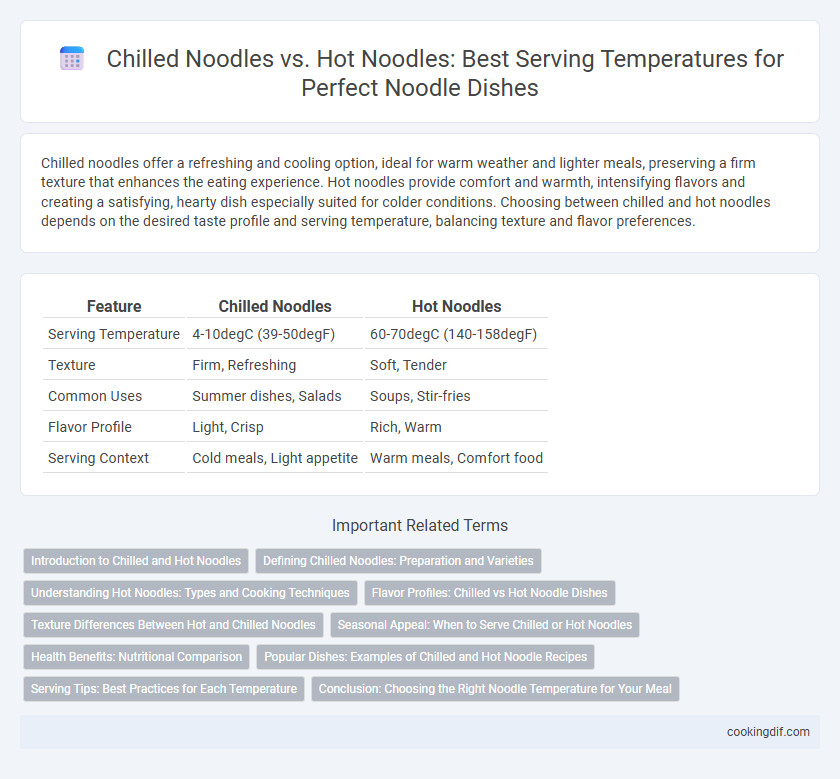Chilled noodles offer a refreshing and cooling option, ideal for warm weather and lighter meals, preserving a firm texture that enhances the eating experience. Hot noodles provide comfort and warmth, intensifying flavors and creating a satisfying, hearty dish especially suited for colder conditions. Choosing between chilled and hot noodles depends on the desired taste profile and serving temperature, balancing texture and flavor preferences.
Table of Comparison
| Feature | Chilled Noodles | Hot Noodles |
|---|---|---|
| Serving Temperature | 4-10degC (39-50degF) | 60-70degC (140-158degF) |
| Texture | Firm, Refreshing | Soft, Tender |
| Common Uses | Summer dishes, Salads | Soups, Stir-fries |
| Flavor Profile | Light, Crisp | Rich, Warm |
| Serving Context | Cold meals, Light appetite | Warm meals, Comfort food |
Introduction to Chilled and Hot Noodles
Chilled noodles offer a refreshing texture and are typically served cold to enhance their chewiness and flavor, making them popular in warm climates and summer dishes. Hot noodles, served steaming, provide comforting warmth and are often paired with rich broths or sauces, emphasizing their softness and enhanced aroma. Both chilled and hot noodles play distinct roles in global cuisine, catering to different tastes and seasonal preferences.
Defining Chilled Noodles: Preparation and Varieties
Chilled noodles are prepared by cooking noodles and then rapidly cooling them in ice water to halt the cooking process and achieve a firm, chewy texture ideal for refreshing dishes. Varieties include Korean naengmyeon, Japanese hiyashi chuka, and Chinese liangpi, each featuring distinct sauces and toppings that highlight cold serving temperatures. The cold preparation preserves the noodles' elasticity and allows vibrant flavors to stand out, contrasting with the softer texture and warmth of hot noodle dishes.
Understanding Hot Noodles: Types and Cooking Techniques
Hot noodles, commonly served in soups or stir-fries, include types like ramen, udon, and soba, each requiring specific cooking techniques to retain texture and flavor. Boiling is the most common method, ensuring noodles are cooked evenly and remain tender while hot water preserves the starch structure. Understanding these cooking techniques helps optimize serving temperature, enhancing the noodle's absorbency and mouthfeel for a satisfying hot dish experience.
Flavor Profiles: Chilled vs Hot Noodle Dishes
Chilled noodles offer a refreshing, crisp texture that highlights bright, tangy, and often spicy flavor profiles, ideal for summer dishes or palate cleansers. Hot noodles deliver rich, comforting tastes with enhanced umami and savory depth, as warmth intensifies spices and broths. The serving temperature significantly influences the balance of flavors, where chilled noodles emphasize freshness and acidity, while hot noodles enhance aroma and richness.
Texture Differences Between Hot and Chilled Noodles
Chilled noodles exhibit a firm, chewy texture with enhanced elasticity due to starch retrogradation during cooling, making them ideal for refreshing dishes. Hot noodles tend to be softer and more pliable as heat gelatinizes starches, resulting in a tender mouthfeel suitable for soups and hot meals. The contrast in serving temperature profoundly influences the noodle's bite and texture perception, critical for culinary applications and consumer preference.
Seasonal Appeal: When to Serve Chilled or Hot Noodles
Chilled noodles are ideal for warm seasons, offering a refreshing and cooling effect that enhances their appeal during spring and summer months. Hot noodles provide comfort and warmth, making them a preferred choice in cooler seasons such as fall and winter. Serving temperature directly influences the seasonal appeal, with chilled options boosting appetite in heat while hot noodles satisfy cravings for warmth in cold weather.
Health Benefits: Nutritional Comparison
Chilled noodles retain more antioxidants and reduce glycemic response, promoting better blood sugar control compared to hot noodles. Cold servings help preserve heat-sensitive vitamins like vitamin C and certain B vitamins, enhancing nutritional intake. Hot noodles can increase satiety and improve digestion through warmth but may cause slight nutrient degradation due to higher temperatures.
Popular Dishes: Examples of Chilled and Hot Noodle Recipes
Chilled noodles are featured in popular dishes like Japanese zaru soba and Korean naengmyeon, prized for their refreshing, cold serving temperature that enhances summer dining. Hot noodles, such as Vietnamese pho and Italian spaghetti bolognese, are traditionally served steaming to maximize flavor and comfort. Both chilled and hot noodle recipes offer distinct sensory experiences, catering to diverse culinary preferences worldwide.
Serving Tips: Best Practices for Each Temperature
Chilled noodles require rinsing under cold water and draining thoroughly to maintain their firm texture, making them ideal for refreshing summer dishes or salads. Hot noodles should be served immediately after cooking and tossed with a bit of oil to prevent sticking and preserve their softness for soups or stir-fries. Proper serving temperatures enhance the flavor absorption and overall mouthfeel, ensuring an optimal dining experience for each noodle type.
Conclusion: Choosing the Right Noodle Temperature for Your Meal
Chilled noodles offer a refreshing texture and are ideal for warm weather or light meals, enhancing flavors without heaviness. Hot noodles provide comforting warmth and richer taste profiles suited for colder climates or hearty dishes. Selecting the right serving temperature depends on the desired flavor intensity, meal context, and personal preference for texture and temperature balance.
Chilled noodles vs hot noodles for serving temperature Infographic

 cookingdif.com
cookingdif.com